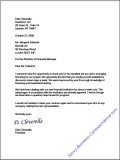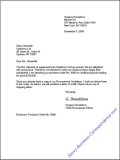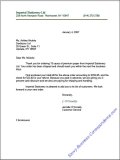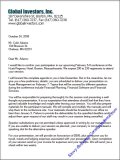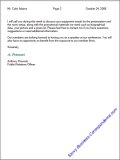Format of Business Letters
Computers nowadays make our life so easy Dixie finds it hard to believe.
With all this new technology formatting business letters has become a breeze. Especially if you know the major rules Dixie has gathered for you in this place. If you use proper format for business letters your letters produce a good impression on the reader... provided the content does not spoil it, of course.
What else could you wish for?
Business Letter Layouts
Dixie suggests we focus here on the following three business letter layouts which are used quite widely: Full, Modified and Indented Block.
Full Block
The Full Block business letter layout is the easiest to format. Here everything starts at the left margin, and Dixie delights in the fact that no tabs are needed. This style is efficient and businesslike. No wonder it has become so popular and it is Dixie's first choice, too. Don't you just like the way it looks?!Each of business letter layouts merits its own page, so go to the Full Block Business Letter page to read about it in more detail and also to see a list of major elements of a business letter.
Dixie thought that she needed to mention though that some critics feel that this layout looks a little crowded. Well... it's good then that there are two more of them, modified and indented.
Modified Block
The Modified Block style's return address (Dixie reminds you that you use the return address only in case there is no letterhead), date, complimentary closing and the signature line are at the center of the paper, or rather to the right of center. Everything else is flush with the left margin. Most of us are comfortable with this business letter layout as it has traditionally been the most commonly used. Judge for yourself how much you like it:
Dixie invites you to go to the Modified Block page on her site where you can try out a modified block format generator, see additional business letter elements and even practice writing a business letter in modified format.
Indented
In case of the indented/semi-block layout the paragraphs in the body are indented one tab stop. So, you need to use two tabs: one for the indented paragraphs and one for the return address (again, in case no letterhead is used), date, complimentary closing and signature line. Dixie thinks this style is a little outdated. On the other hand, most of us are comfortable with it and a lot of companies still use it. This is how it looks:
Again, Dixie has a separate page on her site with an Indented Business Letter Format. Check it out for more details, especially on using a letterhead.
Formatting a Multiple Page Business Letter
Talking about letter layout one has to mention long letters because their formatting has quite a lot of peculiarities. Dixie would like to draw to your attention the fact that a multiple page business letter does not have a closing line or a signature on the first page. Subsequent pages do not contain the letterhead (if there is a letterhead in the letter) and are printed on plain paper. Instead subsequent pages usually contain a special header with the name of the addressee, the page number, and the date. In the picture below Dixie offers to your attention a sample of a multiple page business letter with a letterhead.Dixie invites you to visit her Multiple Page Business Letter page to see more details about formatting such letters.
Some General Points About Business Letter Layout
Whichever layout you are using to format your business letter, try to leave 1-1.5" margins. Dixie suggests you imagine that the margins create a frame around your words, which makes your letter more appealing.
If your business letter is not too long (like has about two or three sentences), start it between 6-12 lines from the top of the page.
Another advice from Dixie, make your paragraphs rather short. We live in the world so crammed with information that a lot of people scan their mail and in the best case read something that catches their attention. And we all know that short paragraphs are easier to read than the long ones. Besides, the white space between the paragraphs provides a resting place for the reader's eyes.
Dixie: "A Few Words about Formatting Letterhead Stationery"
If your stationery has a letterhead, the letterhead stays on top, of course. In this case leave at least two, better three empty lines under it, and if the letter is short leave even more space and try to place the body of the letter in the middle of the page.
Some letterheads also use inscriptions on the left edge of the paper and sometimes (least common, and least convenient in Dixie's expert opinion) on the bottom, and Dixie wants to remind you to leave space for those.
See an example of a business letter with a letterhead above.


|
Email this page | Tweet | You should click one of these buttons to share |

